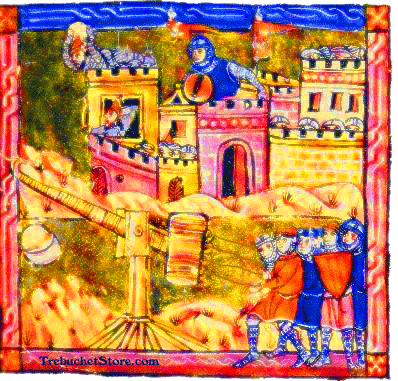Medieval Painting of a Traction
Trebuchet and Crew During a Siege
Besiegers employ a traction trebuchet against a castle, while the
besieged take cover and drop rocks in defense. <<
Back
Unlike the counterweight
trebuchet , the traction trebuchet uses men, the traction crew, pulling
on ropes attached to the short end of the trebuchet
beam, as motive force. Lacking in range and projectile capacity, as compared
to the larger, wall-breaching counterweight trebuchet, the traction
trebuchet was used primarily as light artillery against enemy personnel
and unfortified structures within the castle walls.
 . .
Once fired, the traction crew released tension on the ropes and the
beam returned to cocked or ready position. This allowed an increased rate
of fire over the counterweight
trebuchet , which needed to have the beam and attached counterweight
winched back into the cocked position. The sling crew then reset and reloaded
the sling and the trebuchet was ready to fire.
When using smaller projectiles, one or more crewmembers could take hold
of the sling prior to firing. This imparted increased
tension to the sling and beam and increased range.
On command, the sling crew would release their grip just after the traction
crew began their pull.
Adding or removing men from traction crew allowed some adjustment for
range and projectile weight, but large increases required a disproportionate
amount of manpower. As the traction crew increased, the angle of each added
rope increased, reducing that rope's resultant force. Consequently. each
man added contributed less than the man before.
As projectile weights and fortress size increased, the traction trebuchet
evolved
into the hybrid trebuchet and eventually
the counterweight trebuchet . Massive
fortresses encountered during the Crusades
required enormous trebuchets and set new standards for siege
engines .
|